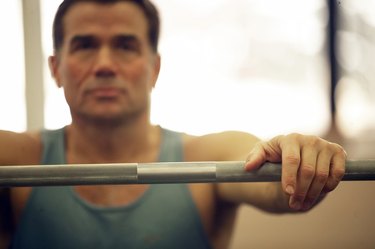
The upright row is a common strength-training exercise. Popular with bodybuilders, athletes and general exercisers alike, the upright row is usually performed with the aim of increasing upper-back and shoulder muscle size. Women often stay clear of this exercise as it tends to also increase neck girth, whereas football and rugby players perform it for exactly this reason.
Performance
Video of the Day
Upright rows are a free-weight exercise commonly performed using a barbell. Grasp a barbell with a hand-width overhand grip. Stand with your feet hip-width apart and the weight resting across your thighs. Pull your shoulders back, lift your chest and arch your lower back slightly. Lead with your elbows and pull the bar up the front of your body and just under your chin. Your elbows should be higher than your hands. Slowly lower the bar back down to full arm extension and repeat. Do not use your knees, hips or back to jerk the weight up as this reduces the effectiveness of the exercise.
Video of the Day
Muscles
The upright row is a compound exercise. Compound exercises utilize multiple joint actions and, therefore, multiple muscle groups. The primary muscles involved in the upright row are the upper trapezius, deltoids and biceps. The upper trapezius and deltoids work together to elevate your shoulder girdle and raise your arms, while your biceps work to flex your elbows. In addition to the major muscles, smaller muscles called synergists and fixators control other parts of your body to facilitate the performance of this exercise. Your core muscles, for example, must generate tension to support your spine as you lift and lower the weight.
Variations
The upright row is most commonly performed using a barbell for resistance but can also be done using dumbbells or a low cable machine for variety. Some prefer to perform the exercise using a shoulder-width grip instead of the traditional hand-width grip. Another variation of the upright row, the high pull, uses a strategic leg thrust to allow you to lift heavier-than-usual weights. This is a common exercise in weightlifting and also popular with athletes.
Considerations
The upright row involves considerable medial or internal shoulder rotation. This action creates significant torque within your shoulder joints. This torque, in turn, places a potentially injurious load on the small muscles that control the stability of your shoulder joint, specifically your rotator cuff. Some exercisers find that upright rows place their shoulders in a mechanically disadvantageous position that can result in shoulder pain. If you find upright rows hurt your shoulders, perform shrugs for your trapezius muscles instead.